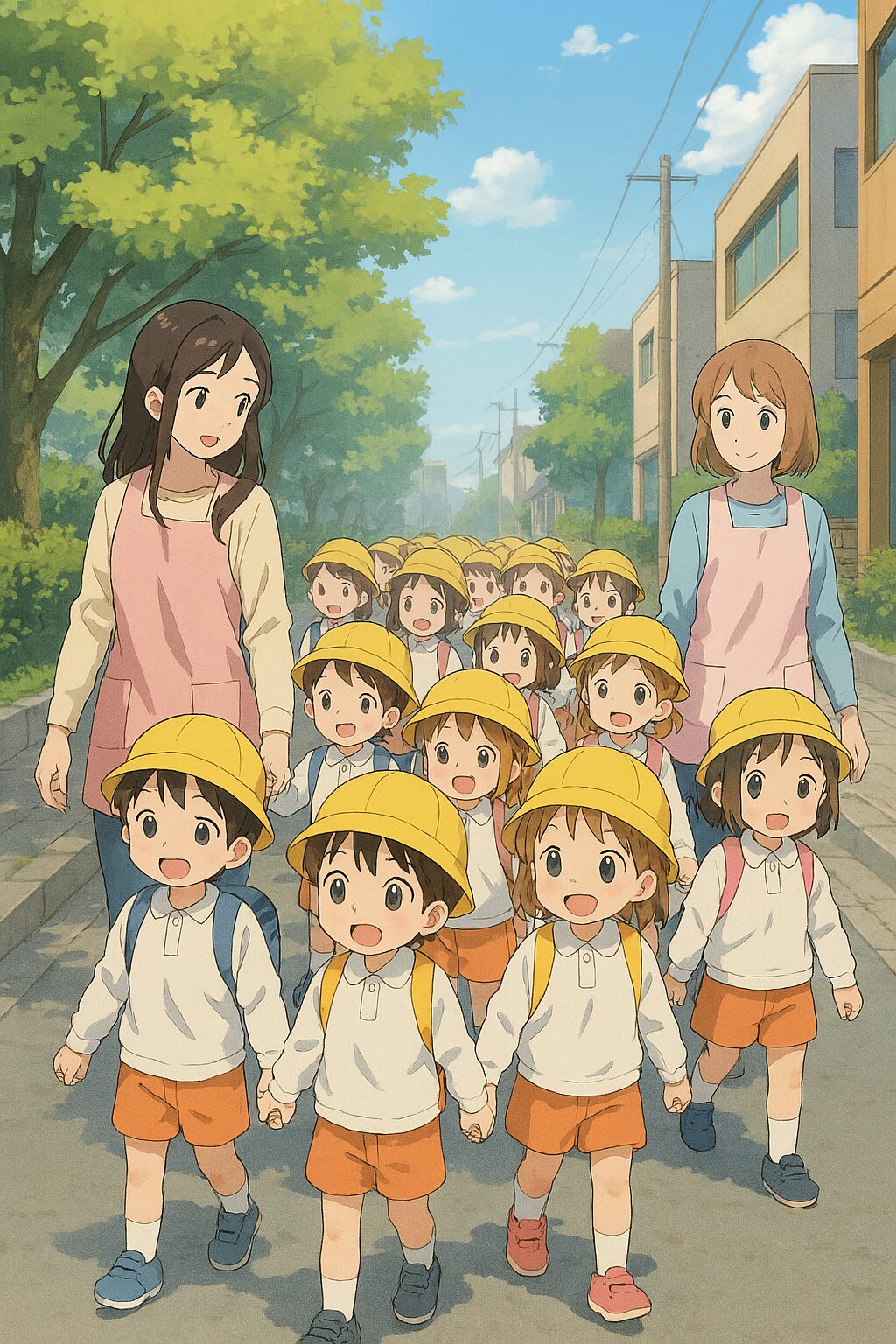Introduction: A Scene That Left My American Friend Speechless
Recently, an American friend visiting Japan witnessed something that stopped him in his tracks.
A group of a dozen kindergarteners, accompanied by a few female caregivers, were quietly walking through the streets of Nara. The children wore yellow hats, held hands, and followed in perfect order. The caregivers smiled gently, occasionally offering soft words of encouragement.
My friend turned to me and said:
“This would never happen in my country. It’s too dangerous. We keep children indoors as much as possible.”
His voice carried a mix of awe, envy, and a touch of sadness.
What’s Normal in Japan Can Feel Like a Miracle Elsewhere
For those of us living in Japan, seeing young children out on a walk with their teachers is a familiar sight. In spring, they stroll beneath cherry blossoms; in autumn, they collect fallen leaves in the park. Passersby smile, cars slow down, and the city seems to cradle them in quiet care.
But in many parts of the world, such outings are unthinkable. Concerns about gun violence, abduction, traffic safety, and general public disorder mean children are often kept inside. In such contexts, Japan’s open and trusting approach to childcare feels like a dream.
Why Is Japan So Safe for Children?
To understand this, we must look beyond surface-level policies and explore the cultural foundations of Japanese society.
- Trust in Public Spaces Japanese streets are relatively clean, orderly, and safe. People follow traffic rules, and even strangers maintain respectful distance and consideration.
- Community Watchfulness When children walk through neighborhoods, adults instinctively keep an eye out. This “watchful kindness” is a form of communal caregiving deeply embedded in Japanese life.
- Dedicated Caregivers Japanese childcare workers are highly attentive and deeply committed to the well-being of their students. Their presence offers both emotional and physical security.
A Culture of Kindness Rooted in the Edo Era
Japan’s safety and gentleness aren’t just modern phenomena—they’re rooted in centuries of cultural values.
For example, this article explores how everyday kindness and mutual care were central to life in the Edo period, and how those values continue to shape modern Japan:
👉 🇯🇵 A Safe Society Rooted in Kindness – What an Edo Era Tale Reveals About Japan
It’s a powerful reminder that Japan’s peaceful public life is not accidental—it’s the result of generations of cultural cultivation.
For International Readers: Japan’s Kindness Is No Coincidence
If you’re reading this from abroad and find yourself amazed by Japan’s public safety, you’re not alone. What feels miraculous to you is deeply normal here—but it’s not taken for granted.
Japan’s safety is upheld not just by laws, but by invisible values: empathy, respect for others, and a sense of shared responsibility for public spaces.
These values are woven into everyday life, from how people walk through the streets to how they care for children.
Conclusion: Turning Everyday Miracles into Shared Stories
The kindergarten walk my American friend witnessed may seem ordinary to Japanese eyes. But to him, it was a revelation—a glimpse into a society where trust, safety, and kindness are lived values.
That’s why we must continue to share these stories. Japan’s culture of empathy and public care is a gift worth offering to the world.
Let’s celebrate the quiet miracles of everyday life—and the centuries of wisdom that make them possible.
- Introduction: A Scene That Left My American Friend Speechless
- What’s Normal in Japan Can Feel Like a Miracle Elsewhere
- Why Is Japan So Safe for Children?
- A Culture of Kindness Rooted in the Edo Era
- For International Readers: Japan’s Kindness Is No Coincidence
- Conclusion: Turning Everyday Miracles into Shared Stories
- 【奇跡のような日常】アメリカ人の友人が驚いた、日本の幼稚園児たちのお散歩風景
【奇跡のような日常】アメリカ人の友人が驚いた、日本の幼稚園児たちのお散歩風景
はじめに:ある日、アメリカ人の友人が目撃した「信じられない光景」
先日、アメリカから来日していた友人が、奈良の街角である光景に目を奪われました。
それは、十数人の幼稚園児たちが、数人の保育士さんに伴われて、手をつなぎながら静かにお散歩している姿。子どもたちは黄色い帽子をかぶり、列を乱すことなく歩いていました。保育士さんたちは全員女性で、笑顔で子どもたちを見守りながら、時折優しく声をかけていました。
その友人は、目を丸くしてこう言いました。
「こんな光景、母国では絶対にありえない。外は危険すぎて、子どもたちを集団で外に出すなんて考えられない。」
彼の言葉には、驚きと羨望、そして少しの切なさが混じっていました。
日本の「安全な日常」は、世界から見れば奇跡
私たち日本人にとって、保育園児のお散歩はごく普通の風景です。春には桜の下を歩き、秋には落ち葉を拾いながら公園へ向かう。道行く人々は優しく声をかけ、車はスピードを落として通り過ぎる。
しかし、世界の多くの国では、子どもたちを外に出すこと自体がリスクとされ、保育施設の中で過ごす時間がほとんどです。銃社会、誘拐のリスク、交通事情、治安の不安…。そうした背景を持つ国々では、日本のような「開かれた保育」は夢物語のように映るのです。
なぜ日本では、子どもたちが安心して外を歩けるのか?
この問いに答えるには、日本社会の根底にある価値観を紐解く必要があります。
- 公共空間に対する信頼 日本では、公共の場が比較的清潔で安全に保たれています。ゴミが少なく、交通ルールが守られ、見知らぬ人同士でも一定の距離感と配慮があります。
- 地域社会の目 子どもたちが歩いていると、周囲の大人が自然と目を配ります。これは「見守り文化」とも言えるもので、地域全体が子どもを育てるという意識が根付いています。
- 保育士の献身と信頼 保育士さんたちは、子どもたちの安全を第一に考え、細やかな配慮を欠かしません。彼女たちの存在が、子どもたちの安心感を支えているのです。
江戸時代から続く「やさしさの文化」
このような日本の安全性とやさしさは、実は江戸時代から続く文化的土壌に根ざしています。
たとえば、以下の記事では、江戸時代の庶民の暮らしの中にあった「思いやり」や「助け合い」の精神が、現代の日本社会にも受け継がれていることが語られています。
👉 🇯🇵 A Safe Society Rooted in Kindness – What an Edo Era Tale Reveals About Japan
この記事では、江戸時代の庶民がどのようにして「安全な社会」を築いていたのか、そしてその精神が現代の日本人の行動や価値観にどう影響しているのかが、丁寧に描かれています。
海外の読者へ:日本の「やさしさ」は偶然ではない
もしあなたが海外に住んでいて、日本のこうした光景に驚いたなら、それは当然のことです。日本の安全性は、単なる制度や法律によって守られているわけではありません。
それは、人々の心の中にある「他者への配慮」「弱者へのまなざし」「公共への責任感」といった、目に見えない価値観によって支えられているのです。
そしてそれは、長い歴史の中で育まれてきた文化の結晶でもあります。
結び:奇跡のような日常を、奇跡として伝える
アメリカ人の友人が目撃した、幼稚園児たちのお散歩風景。それは、日本に住む私たちにとっては当たり前のものかもしれません。
しかし、その「当たり前」が、世界の多くの人々にとっては「奇跡」に映る。
だからこそ、私たちはこの日常を、もっと丁寧に語り継いでいく必要があるのではないでしょうか。
日本の文化の根底にある「やさしさ」と「安全性」。それは、世界に向けて発信すべき、かけがえのない物語です。



コメント